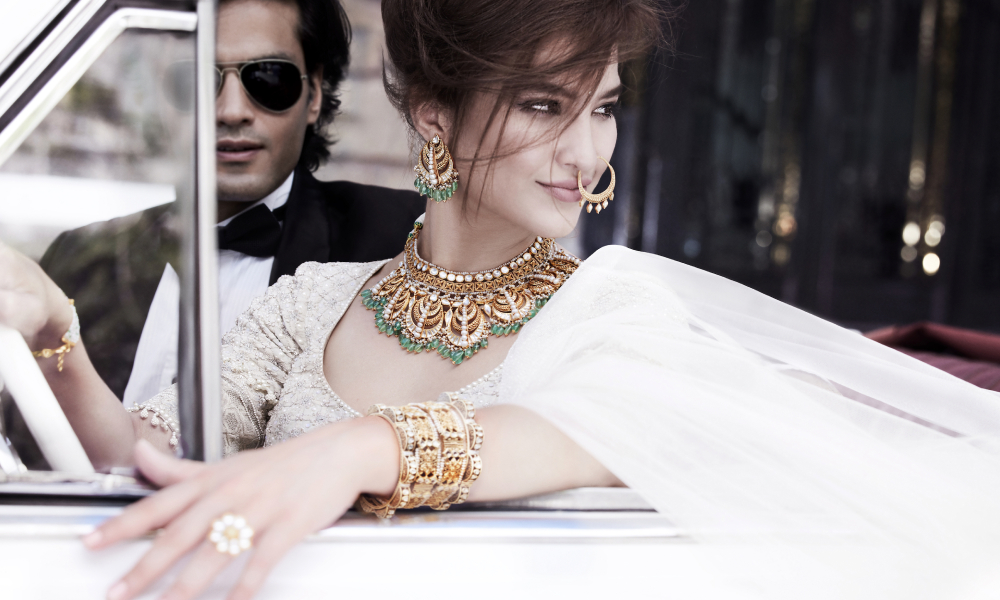For centuries, hair accessories have been used as a sought-after adornment for royalties in every notable culture in the world. While Western traditions have used tiaras to represent nobility, India’s fine jewellery karigars conceived hair accessories beyond the crowning jewel and created diverse ways for Indian royalty to flaunt precious ornaments on intricate haristyles. Maatha-Patti, or Maang-Tikka with an extension to the nose ring that subsequently became an indispensable part of ‘Shringaar’ (adornment) for royal princesses and queens are making a regal revival for modern day brides.
Head-turners
Modern-day brides are opting for unconventional hairstyles that allow them to zestfully waltz down the wedding aisle on their important day. Bollywood brides, too, embracing this trend. Parineeti Chopra, Katrina Kaif and even Alia Bhatt chose to let their soft waves fall pretty under soft net or transparent dupattas for their D-day looks. “The thick and heavily ornate dupattas are being replaced with sheer and light veils giving opportunity for hair adornment to stand out,” notes Garima Maheshwari, head of design at Tanishq, “Hence brides are really looking at extra hairstyling with jewellery.”
Hair accessories are trending in various forms and styles. “We have observed matha pattis (head bands) along with sheesh phool (floral pendants) are in vogue. In its many avatars as a head band or a simple string of gold or glittering diamonds, matha pattis accentuate and frame the brides face beautifully,” adds Maheshwari.

Vandana Jagwani, creative director at Mahesh Notandass Fine Jewellery has been designing intricate jewelled headbands for her bride clients “so they can be reused for other occasions in the future,” she says, adding, “We use all sorts of gemstones and diamonds.”
Some brides chose to go with a single maang tikka while some prefer to add the extra layer of matha patti that frames the forehead, along with a string that connects to a lightweight nose ring.
The Nathani Craze
Some reports refer to ancient Ayurvedic studies that associate benefits of wearing a nose pin with healthier menstrual and birthing experiences for women, as certain pressure points on the nostrils are said to be linked to the reproductive system. Adorned for many centuries by Indian women, sometimes delicate and even elaborate nose rings can be spotted on dreamy oil-portraits of royal princesses and queens and even ancient sculptures of deities, establishing the accessory’s customary adoption.
Fast forward to the 21st century, the Nathani or the nose-pin has come to become a genteel accessory in the bride’s D-day ensemble, adding a flirtatious grace to her demure face.
This decade’s Bollywood brides have also been seen wearing the nose ring, fashioned in either traditional yellow gold alone or clubbed with pearl or diamond drops that dance and glint with every smile of the bride.
“Nose pins and nose rings may or may not be a necessity for every bride, but they are important if the bride is aiming at achieving a more traditional look,” says Jagwani.
“In north India, diamonds are trending for the nathani. In the south, where brides aim to complete the Solah Shringar (16 ornaments) attire, they definitely include the nose pin,” she explains, adding that in order to modernise nose pins, diamonds are used with a yellow gold base.
Brides, today, are adopting these heritage accessories as a way to honour and embrace their culture and Indian roots, “Our recent Rivaah collection has a great range of stylised nose rings for the modern-age, free-spirited bride who takes immense pride in her heritage and roots while flaunting this accessory,” asserts Maheshwari.

